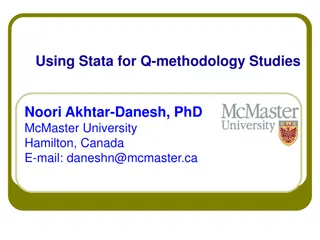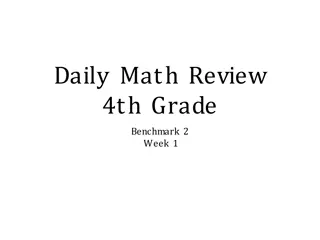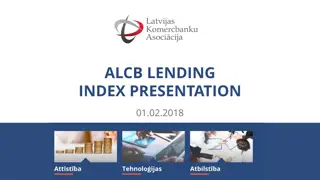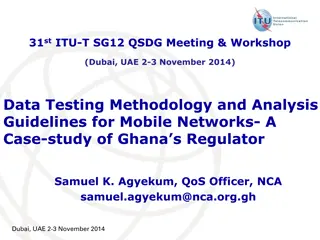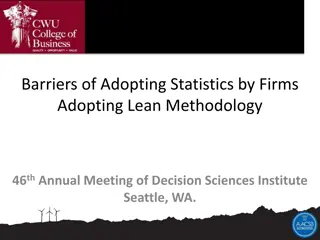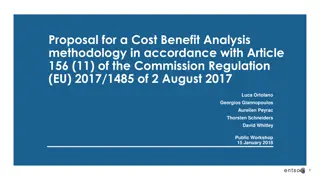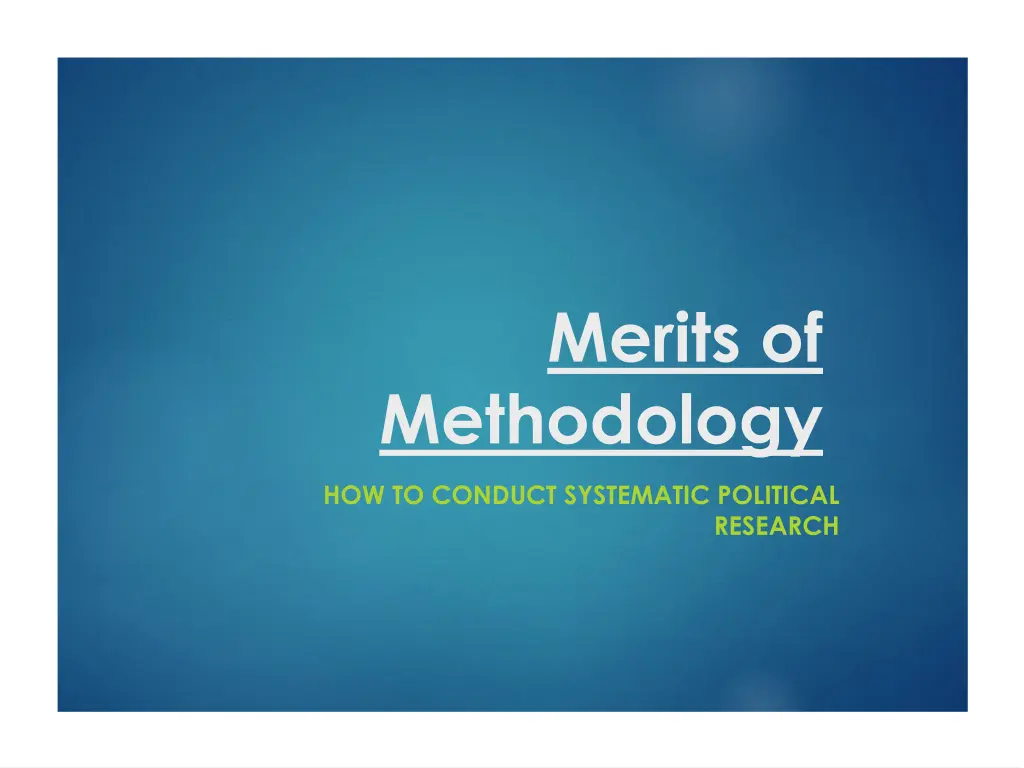
Conducting Systematic Political Research Methodology
Learn about the merits of methodology in conducting systematic political research, including the types of evidence needed, analysis methods, and different methodologies used. Understand the importance of differentiating between theory-testing and theory referral, qualitative and quantitative evidence, and various basic methods in political studies. Explore the relevance of methodology in answering key questions related to comparative politics, regime types, democracy, political systems, and more.
Download Presentation

Please find below an Image/Link to download the presentation.
The content on the website is provided AS IS for your information and personal use only. It may not be sold, licensed, or shared on other websites without obtaining consent from the author. If you encounter any issues during the download, it is possible that the publisher has removed the file from their server.
You are allowed to download the files provided on this website for personal or commercial use, subject to the condition that they are used lawfully. All files are the property of their respective owners.
The content on the website is provided AS IS for your information and personal use only. It may not be sold, licensed, or shared on other websites without obtaining consent from the author.
E N D
Presentation Transcript
Merits of Methodology HOW TO CONDUCT SYSTEMATIC POLITICAL RESEARCH
Lecture Structure 1. The What and Why of Methodology. 2. Theory-testing vs. Theory referral. 3. Qualitative and Quantitative Evidence. 4. 3 Basic Methods. Large N. Small N / Comparative Methods. Single Case Study.
1 The What and Why of Methodology WHAT IS IT? WHY DO WE USE IT?
What is Methodology? It is the way we go about answering questions. We have different choices What type of evidence do I need? How do I analyse the evidence? In political studies this usually means that we need to consider how different concepts relate to one another.
Why do we use different methodologies? This course asks a variety of questions: How do study comparative politics (methods)? The nature of the contemporary state? What are the different regime types and transitions? The survival and significance of democracy? Political systems, parties, civil societies and social movements? Revolutions and their occurrences?
Why do we use different methodologies? There are different ways (methods) of answering these questions. The type of question asked suggests the type of method you need in order to answer it The method you use means that you must go about answering the question in a specific way. All methods, if done right, ensure that you systematically address the question.
Consider What are the similarities and differences between Eva Bellin (2004) and Gandhi & Przeworski s (2007) studies?
Comparing methodologies: Bellin (2004) Small n study: Authoritarianism in the Middle East Time Series: 1972-2001 Evidence: Qualitative Gandhi & Przeworski (2007) Large-N study: Autocratic Survival Time series: 1946 - 1996 Evidence: Quantitative
2 Distinguishing between theory- testing and theory referral
Distinguishing theory-testing and theory referral Theory: an attempt to logically and systematically explain real-life phenomena Theory-testing: You are using the logic of a theory to explain your case(s) DO NOT deviate from logic DO NOT try to fit the theory to the case REMEMBER that a single observation does not prove/disprove the theory
Steps for Theory-Testing Logic of theory Language that a theory demands Units of analysis Consistency through the paper Acknowledging limitations
Distinguishing theory-testing and theory referral cont. Theory referral: This is less restrictive than theory-testing approach Can use theory to add to understanding (illustrative)
3 THOROUGH UNDERSTANDING OF A FEW. Qualitative and Quantitative Evidence VS. CURSORY UNDERSTANDING OF MANY.
Types of Evidence Qualitative and quantitative data are different types of evidence that can be used to answer a question They are not methods. They can imply that certain methods be used in order to use them. They are not mutually exclusive Q-squared = both quantitative and qualitative evidence used
Qualitative Evidence Concepts are analysed based on interpreting and cross-verifying data collected. Narrative evidence often gathered through interviews; focus groups; discussions; etc. Questions asked can be open-ended; semi-structured; close-ended. Need to learn techniques for interpreting the data collected. See: Portelli, A., Oral History as Genre , in M. Chamberlain and P. Thompson (eds.) Narrative and Genre: Contexts and Types of Communication, (Transaction Publishers, 1998), pp. 23-45. Thompson, P., The Voice of the Past: Oral History, 3rd ed., (Oxford University Press, 2000).
Quantitative Evidence Concepts are measured in terms of numbers. Operationalise a concept called a variable. Types of variables: Dependent variable: the outcome; Y. E.g. Crime rates Independent variable(s): the factors that cause the outcome; X. E.g. Poverty Variables are measured using indicator(s). Proxies are indicators for indicators. E.g. Development and Human Development Index (HDI)/GDP per capita.
How do we measure the following concepts? Democracy? Authoritarianism? Poverty? Inequality?
Advantages Qualitative Quantitative Natural unfolding of study. Can compare large number of cases across time and/or geography. Thick description . Social meaning. Relationships of prediction can be identified. Micro-level impact. In-depth understanding of case. Lower risk of researcher s directly influencing data. Helps answer the why . Can apply statistical tools. Generalisable. Relatively cheap.
Disadvantages Qualitative Quantitative Issues of subjectivity and interviewer influence Risks overlooking context(s) of case(s). Time-consuming Lacks substance about the meaning of what is tested. Expensive Finding suitable data can be difficult need large studies. Not easily generalised.
Disadvantages Qualitative Quantitative Issues of subjectivity and interviewer influence Risks overlooking context(s) of case(s). Time-consuming Lacks substance about the meaning of what is tested. Expensive Finding suitable data can be difficult need large studies. Not easily generalised. NOT DICHOTOMOUS!! Often a degree of each.
4 LARGE-N: > 50 CASES. SMALL-N: 2-20 CASES. SINGLE CASE STUDY: 1 CASE. 3 Basic Methods N = NUMBER OF CASES/OBSERVATIONS.
Large-n Study N = 50+ cases Advantage: compare a large number of cases. Evidence: usually quantitative; many variables; statistical techniques. Examples: Przeworski and Limongi 135 countries 1950-1990 229 observed regimes: 101 democratic and 123 authoritarian Note: Samuel Huntington s Clash of Civilizations uses qualitative evidence but through Large-N analysis
Small-n aka. comparative method . N = 2 20 cases compared. Cases are deliberately selected in order to establish control. Most Similar Systems Design (MSSD). Similar cases. Different outcome. Most Different Systems Design (MDSD). Different cases. Same outcome.
Can you think of 1. An example of a small-n analysis that we have covered thus far in the course?
Single Case Study N = 1 Evidence: often qualitative A single country can be the unit of analysis. It can be further divided into time periods; geographical spaces; and different levels of analysis.
Why do a Single Case Study? Classification of case. Contextual ( thick ) description. Hypothesis generation. Theory testing: Most likely study. Least likely study. Outliers. Can test causal explanations. You will be looking at a lot of single case studies for you course essay (choose 2 country cases)
Limitations of Single Case Studies Limited scope/generalisability. Selection bias. See: Landman, Todd. 2007. Issues and Methods in Comparative Politics: An Introduction. London: Routledge.
What we looked at: 1. The What and Why of Methodology. 2. Theory-testing vs. Theory referral. 3. Qualitative and Quantitative Evidence. 4. 3 Basic Methods. Large N. Small N / Comparative Methods. Single Case Study.

